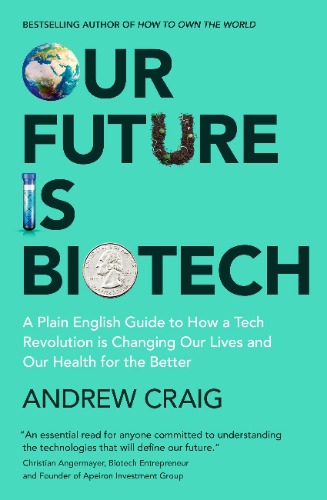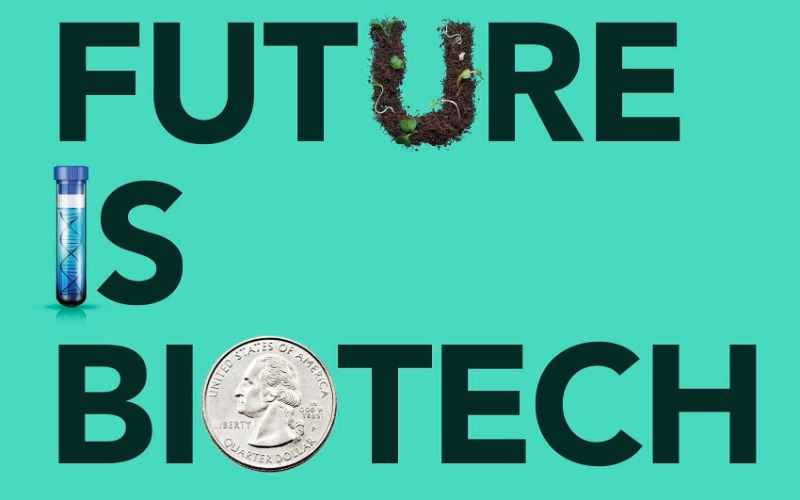
The following is an excerpt from OUR FUTURE IS BIOTECH by Andrew Craig (John Murray Business).
Sir Arthur C. Clarke, the British author who gave us 2001: A Space Odyssey, famously stated as one of his Three Laws that ‘Any sufficiently advanced technology is indistinguishable from magic.’ There is a great deal of ‘magic’ going on out there, for those willing to seek it out. Science fact increasingly looks like science fiction. That magic is also highly likely to create several trillion ‘currency units’ of real economic value in the next few decades, to our great benefit as a species. It is the people at work in this sector who will be instrumental in ensuring the continuation of the unimpeachably fantastic progress our species has made in the last few centuries into the next few.
In this book, I make the case that the world is already the best it has ever been for humanity in aggregate. Notwithstanding the daily deluge of negativity that comes from our press, the reality is that human experience for the vast majority of people has been steadily improving for at least two centuries.
The incredible progress made by our species in the time since the Agricultural and Industrial Revolutions and the dividends paid for many billions of us alive today cannot be understated. In the main, that progress has been delivered by technological development – by the ‘tech’ industry if you like. Many of the remaining challenges we face will be addressed by the (bio) tech industry, if only due to the inherent nature of many of those challenges and the extent to which they involve biological systems.
All of this will create very significant economic value and pay real dividends for every aspect of our lives and for our impact on the planet too.
Some Biotech Magic
One of the singular privileges of my time working in the biotech sector has been getting to meet the senior management teams of a large number of companies face-to-face and being able to visit their facilities and speak to their commercial staff and scientists.
Time after time, I find myself stumbling across things that are really quite extraordinary and where science fact really does look like the science fiction of only a few years ago. Here are a few examples, in no particular order:
● An Australian company, QBiotics, that has spent more than 20 years going into the Australian rainforest looking for natural compounds that might have anticancer, wound healing and antimicrobial properties. Its lead drug can be injected directly into any tumor that can be biopsied – that is to say, the significant majority of tumours. So far, it has shown an astonishing ability to destroy those tumours and to achieve exceptional on-site wound healing thereafter.
● A highly innovative British company, Oxford Biomedica, has been a world leader in a particular kind of biotech manufacturing process for more than 20 years. In that time, it has focused on scaling up and injecting as much efficiency into that process as possible, with much larger batches, clever software, automation and robotics, for example. Doing so has meant that it is able to take the manufacturing cost of a particular cancer treatment down tenfold, from a level that was too high to make that treatment commercially viable, to one which meant that Novartis – the company behind that treatment – was able to launch the drug.
● A Belgian company, Ablynx, which has used antibodies from llamas (yes, llamas!) ‘to create new therapeutics and refine existing treatments’. The company spun out of a Belgian research institute in 2001 and 20 years later was acquired by French pharmaceutical giant Sanofi for just shy of $5 billion. There are other companies elsewhere in the world doing similarly innovative things, including one in Australia which is using, of all things, shark antibodies!
● Another British company, Avacta, with a similar technology (although using human proteins rather than anything from a llama or a shark this time) may be able to use that technology to deliver a kind of highly targeted chemotherapy. That is to say that it may be able to manufacture a chemo drug which is released only when it arrives in the tumour microenvironment, thus reducing the horrendous side effects usually associated with chemotherapy very significantly, quite possibly even getting rid of them altogether. Eventually, its technology may be able to develop a simple oral pill for cancer with no side effects, as crazy as that may sound.
● A Nobel Prize-winning technology, CRISPR, means that it is now possible to change the DNA of animals, plants and microorganisms with extremely high precision. CRISPR has had a massive impact across the life sciences, is contributing to new cancer therapies, and may eventually be able to cure inheritable diseases.
We are in the process of very significantly improving our understanding of the extraordinary complexity of microorganisms – the bacterial ‘biome’ and viral ‘virome’ – in each of us and in our environment more generally. This could be described as a new frontier of sorts and will have far-reaching consequences for health and healthcare in the years ahead.
We are on the cusp of a step-change in ‘wearable’ tech and development of the idea of ‘the quantified self’ which will very likely significantly improve our health and, happily, go some way to shifting the focus of our healthcare systems far more towards prevention than cure. Leading US entrepreneur Peter Diamandis has described this as a move from ‘sick care’ to ‘continuous healthcare’.
One of the most exciting potential uses of biotech in agriculture is that of cell-cultured foods – the development of meat cultivated from cells rather than animals. We may be only a decade or two away from being able to bioengineer all kinds of animal protein so accurately that it will look, smell and taste precisely the same as the beef, lamb, chicken, tuna or lobster that many of us enjoy today, but will have been grown in culture in a lab – quite possibly only a mile or two away from where we live. This approach will be infinitely more efficient, humane and positive for the environment than our current methods of securing such animal protein by growing and then slaughtering billions of animals each year and shipping meat hundreds or even thousands of miles.
But just as there is the potential for such technologies and businesses to make an extraordinary contribution to our future, there are some very particular structural challenges faced by many of the companies working in the sector that are slowing progress.
Outside of the USA, many innovative biotech companies face an extremely difficult funding environment. There is too little capital willing and able to support companies which could be changing the world and significantly improving our lives. This is compounded still further by the fact that there are too few journalists willing to write about what they are doing. Of course, these two things are related. When it comes to the innovation we might be making, we are fighting with one hand tied behind our back. We could be moving a great deal faster, were this not the case.
It’s All About Those Microbes
The Human Genome Project has estimated that humans have between 20,000 and 25,000 genes. This is a tiny fraction of the number of genes that are found in our microbiome, that is to say in the trillions of bacteria that lurk in us and on us. As reported in ScienceDaily in 2019, a team of scientists at Harvard Medical School ‘set out to estimate the size of the universe of microbial genes in the human body, gathering all publicly available DNA sequencing data on human oral and gut microbiomes. In total, they analysed the DNA of some 3,500 human microbiome samples, of which more than 1,400 were obtained from people’s mouths and 2,100 from people’s guts. ‘They found that there were nearly 46 million bacterial genes from those 3,500 samples. Extrapolating from that data, they suggested that, in total: ‘There may be more genes in the collective human microbiome than stars in the observable universe.’
In recent years it has become increasingly clear that our microbiome and virome have an extremely important role to play in our health overall. As that Harvard study put it:
Mounting evidence has revealed the role of […] microbes as powerful modulators of disease and health […] have been linked to development of conditions ranging from […] dental caries and gut infections to […] chronic inflammatory bowel disease, diabetes and multiple sclerosis.
Falling rates of infectious disease have correlated with rising rates of chronic illness all over the world. It now seems clear that the reason for this has to do with the extent to which our infectious disease fighting technologies and our lifestyles have affected the balance of our microbes.
There are clues that this is the case everywhere we look. Arguably of most significance is the fact that some 80 per cent of our immune system is found in the gut. Crucially, our gut is also where an estimated 95 per cent of our microbiota can be located (our own personal bacteria).There is a causal relationship between the quantity and quality of our gut ‘flora’ and the efficient functioning of our immune system and, by extension, our health overall.
Dysbiosis
‘Dysbiosis’ is the term used to describe a compromised or imbalanced microbial community in the human gut. Research conducted over the last several years has implicated dysbiosis in disease after disease, including essentially all of these chronic diseases of modernity as well as cancer, obesity and a wide range of mental health conditions, including depression.
The relationship between our gut health and our health overall, particularly our mental health, is sometimes described by clinicians, scientists and nutritionists as ‘Gut and Psychology Syndrome’, or GAPS. GAPS is a theory that suggests a link between the health of the digestive system and the development of neurological and psychological disorders and a number of other conditions, including depression, anxiety and schizophrenia. When we consider the list of things which cause dysbiosis, we find the causal link between reducing rates of infectious disease and rising chronic illness and can see clearly why those illnesses are so often diseases of affluence and modernity.
Specifically, risk factors for dysbiosis include: a poor diet, including too much sugar (and alcohol); the ‘accidental’ consumption of chemicals such as those commonly found in pesticides and elsewhere in the consumer products of our modern, industrialized world; excessive use of antibiotics, and high levels of stress. As should be abundantly clear from this list, all of these factors correlate with rising development and affluence, particularly the use of antibiotics, for example.
Another key related factor is sometimes described as ‘the hygiene hypothesis’. As leading US healthcare group the Mayo Clinic explains: ‘The hygiene hypothesis proposes that childhood exposure to germs and certain infections helps the immune system develop. This teaches the body to differentiate harmless substances from the harmful substances that trigger asthma. In theory, exposure to certain germs teaches the immune system not to overreact.’ This is thought to be why ‘American children living in poverty are historically less likely to suffer from food allergies and asthmas than their wealthier counterparts.’
It is also why numerous studies have found rates of allergies and other chronic conditions are lower for children growing up in rural settings and on farms than for their urban-dwelling peers. As a 2015 Science article by Martijn J.Schuijs and colleagues has put it: ‘People who grow up on dairy farms only rarely develop asthma or allergies. This is probably because, as children, they breathe air containing bacterial components, which reduce the overall reactivity of the immune system. ‘This is also very likely to be the reason that children in many migrant populations suffer increased rates of all of these sorts of health conditions as we have already seen.
Another increasingly well-documented risk factor for all of the above is the rise of children being delivered by Caesarean section. Globally, rates of Caesarean section have doubled in the last decade and a half to 21 per cent, leading one of the world’s oldest peer-reviewed medical journals, The Lancet, to describe what they deem to be the ‘overuse’ of C-section as nothing less than an ‘epidemic’. One of the reasons for their position is because, as a 2020 study by Gyungcheon Kim and colleagues published in Frontiers in Microbiology explains, Caesarean delivery is associated with ‘the perturbation and delayed maturation of gut microbiota in early life, which in turn has been associated with increased risk of childhood obesity, asthma, immune diseases and infectious outcomes’.
It is becoming abundantly clear that a modern, affluent, excessively sterile and overly medicated lifestyle, particularly when it involves the use of large quantities of antibiotics, can significantly compromise our gut flora and, by extension our immune system and our health. This is highly likely to be one of the key common causal factors leading to the rise in so many chronic health conditions all over the world and in the developed world in particular.
That is the bad news. The good news, however, is that we seem to have finally worked out what the problem is and, increasingly, what we might be able to do about it.
Of course, we don’t want to lose so many of the benefits of modernity and, most particularly, our ability to fight infectious disease with anti- microbials and vaccines. As we have seen, giving up such things would take us back to a world where hundreds of millions of us might die unnecessarily. Surgery would become prohibitively dangerous, for example. Equally, however, we don’t want our societies to continue to endure this inexorable rise in diabetes, obesity, depression and so much else besides, which have come as a natural consequence of that modernity and of our use of vaccines and antimicrobials.
Happily, it is highly likely that we will be able to ‘have our cake and eat it’. Part of the reason I believe this to be the case has to do with the fact that the wealthiest within society have shown themselves most able to avoid much of the chronic disease epidemic. This is because such individuals so often have access to the latest and best health information, the best healthcare, and the freedom in terms of time and money to make the healthiest choices around diet, exercise and supplementation for example. Economic growth and technological development will make these advantages available to an increasing percentage of the population, just has been the case with every other element of human progress since the Industrial Revolution, whether the radio, car, plane, television, personal computer or smartphone.
If there is one primary solution to so many of these diseases of modernity, it seems likely to lie in our ability to deal with dysbiosis, particularly in our children as their gut flora develops. We need to ensure that our microbiota and our immune systems and those of our children, do not become excessively compromised by these various risk factors of modernity. Encouragingly, to do that we may need nothing more than better information and a willingness to take consistent action and implement habits which reduce the risk of dysbiosis and the many health problems it can inflict.
For many, repairing a compromised gut microbiome with all that this implies for the effective functioning of their immune system and a reduction in chronic disease, may ‘only’ require better diet and nutrition, supplementation with probiotics and a number of lifestyle choices around things like sugar consumption, sleep, exercise and the ability to deal with stress. At present, too few people have sufficiently good information about such things, but I would argue that this is changing and will likely do so at an exponential rate going forwards, in large part thanks to the biotech and tech industries.
©2024 John Murray Business. Reprinted with permission. This article may not be reproduced for any other use without permission.











